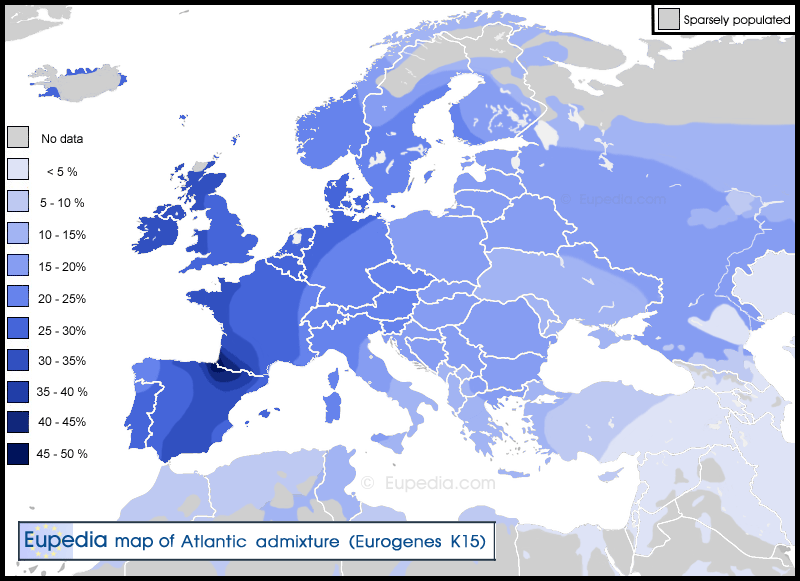The autosomal analysis of Haak et al 2015 samples showed that Mesolithic Russian lacked the Atlantic admixture from Eurogenes K15 now found throughout Europe, even among Uralic speakers (Finns, Saami, Mordovians, Udmurts). Some Yamna genomes also lacked it, while others carried only a few per cents. Considering the major genetic impact that Yamna people had on the European population, it made me wonder who could have spread that Atlantic admixture after the Indo-European migrations.
The Atlantic admixture is most common in regions associated with the Megalithic culture, including the Bell Beaker phenomenon. But its range is much wider than that.
I have a hunch that it is linked to the diffusion of mtDNA V, which appears to have originated in Southwest Europe during the Mesolithic, but has never been found to date in any ancient sample (possibly in Neolithic Iberia in samples that were tested only for HVR1 and HVR2 and cannot distinguish between HV, H and V). There is also a strong correlation with mt-haplogroups H1 and H3, hence the choice of colour for the map.
As you can see the so-called Atlantic admixture peaks in the Basque and neighbouring populations, followed by the Irish, Welsh and Scots. But apart from that it isn't really centred on the Atlantic. Galicians have less of it than Danes and North Germans. The high frequency in Sardinia, but much lower frequency in South Italy and the Balkans indicate a Mesolithic Western European ancestry.

The Atlantic admixture appears to be a hybrid of Mesolithic hunter-gatherers and Neolithic farmers. All Mesolithic and Neolithic samples from Western Europe had about 25% of it. The only exception is for Mesolithic HG from Sweden (Motala) who had only 10%.
What is surprising is that the modern frequencies have hardly changed at all in the last 7000 years in all these regions (Sweden being intermediary between the two samples, but closer to the Neolithic), despite the Indo-European invasions.
On the other hand, the Atlantic admixture appears to have spread eastward since the Bronze Age, as it was virtually absent from Russia even 4000 years ago.
There hasn't been any major historical migrations from west to east in Europe. It has always been the other way round. Therefore the most likely explanation for its diffusion eastward is by intermarriage between neighbours (on the scale of several millennia) and minor migrations like that of medieval Germans to Poland, Romania and the Volga, or Swedish Vikings to Eastern Europe.
The Atlantic admixture is most common in regions associated with the Megalithic culture, including the Bell Beaker phenomenon. But its range is much wider than that.
I have a hunch that it is linked to the diffusion of mtDNA V, which appears to have originated in Southwest Europe during the Mesolithic, but has never been found to date in any ancient sample (possibly in Neolithic Iberia in samples that were tested only for HVR1 and HVR2 and cannot distinguish between HV, H and V). There is also a strong correlation with mt-haplogroups H1 and H3, hence the choice of colour for the map.
As you can see the so-called Atlantic admixture peaks in the Basque and neighbouring populations, followed by the Irish, Welsh and Scots. But apart from that it isn't really centred on the Atlantic. Galicians have less of it than Danes and North Germans. The high frequency in Sardinia, but much lower frequency in South Italy and the Balkans indicate a Mesolithic Western European ancestry.

The Atlantic admixture appears to be a hybrid of Mesolithic hunter-gatherers and Neolithic farmers. All Mesolithic and Neolithic samples from Western Europe had about 25% of it. The only exception is for Mesolithic HG from Sweden (Motala) who had only 10%.
| Prehistoric samples | Atlantic admixture |
| Mesolithic La Braña (Asturias, Spain) | 27.3% |
| Mesolithic Loscbour (Luxembourg) | 29.5% |
| Neolithic farmer from Stuttgart (LBK culture) | 23.2% |
| Ötzi the Iceman (Chalcolithic farmer from the Alps) | 25.5% |
| Gökhem2 (Swedish Neolithic farmer) | 27.7% |
| Motala12 (Mesolithic HG from Sweden) | 10.1% |
What is surprising is that the modern frequencies have hardly changed at all in the last 7000 years in all these regions (Sweden being intermediary between the two samples, but closer to the Neolithic), despite the Indo-European invasions.
On the other hand, the Atlantic admixture appears to have spread eastward since the Bronze Age, as it was virtually absent from Russia even 4000 years ago.
There hasn't been any major historical migrations from west to east in Europe. It has always been the other way round. Therefore the most likely explanation for its diffusion eastward is by intermarriage between neighbours (on the scale of several millennia) and minor migrations like that of medieval Germans to Poland, Romania and the Volga, or Swedish Vikings to Eastern Europe.
Last edited:


